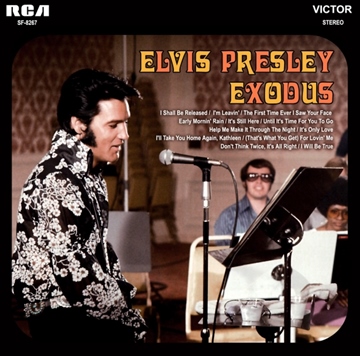“Elvis Presley: Exodus” - the album that was never released - is an exploration of adult relationships expressed through the medium of folk music.
When RCA released the best of Elvis' 1971 secular recordings spread over two albums and singles it was a grave error which robbed Elvis' legacy of a potentially vital LP.
With the official 'Elvis: Back In Nashville' about to be released and to mark the fiftieth anniversary of the recording sessions, I’ve taken the opportunity to lay the ghosts to rest and finally assemble my definitive collection of secular 1971 tracks: this is the 1971 album that should have been.
EIN contributor George Smith reflects on Elvis' 1971 Nashville Sessions and the album that never was...
|
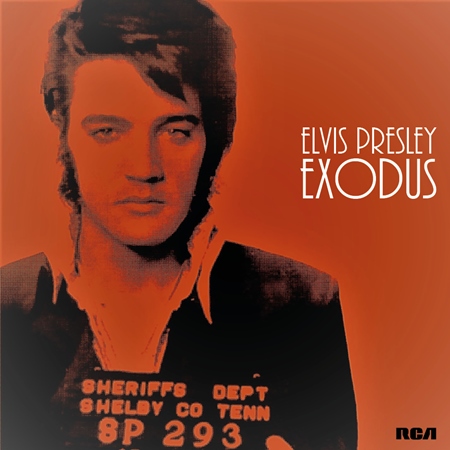 |
'Elvis 1971: Exodus' -
by George Smith
“Elvis Presley: Exodus” is an album that has haunted me for over 30 years.
In reality, of course, it doesn’t exist: in fact, there’s not an Elvis album remotely like it at all.
But in my world, this LP was released in the summer of 1971, following hot on the heels of the glorious “Elvis Country: I’m 10,000 Years Old”.
“Elvis Presley: Exodus” is an exploration of adult relationships expressed through the medium of folk music.
With the official 'Elvis: Back In Nashville' about to be released and to mark the fiftieth anniversary of the recording sessions, I’ve taken the opportunity to lay the ghosts to rest and finally assemble my definitive collection of secular 1971 tracks: this is the 1971 album that should have been.
I’ve collected my thoughts regarding the songs and the circumstances surrounding their recording: apologies for the length of this article but I have much to say about this lost masterpiece.
If the Nashville 1971 material isn’t your bag then keep movin’ down that long lonesome road.
But if it is, make yourself comfortable and welcome to my world … |
 |
Elvis Presley: “Exodus”
1 (Prologue): “I Shall Be Released”
2: “I’m Leavin’”
3: “The First Time Ever I Saw Your Face”
4: “Early Mornin’ Rain”
5: “It’s Still Here”
6: “Until It’s Time For You To Go”
7: “Help Me Make It Through The Night”
8: “It’s Only Love”
9: “I’ll Take You Home Again, Kathleen”
10: “For Lovin’ Me”
11: “Don’t Think Twice, It’s All Right”
12: “I Will Be True” |
Go here to SPOTIFY to listen to this 1971 album
Cover design by David Parker (see info below)
Elvis Presley: “Exodus”
1 (Prologue): “I Shall Be Released” (Bob Dylan / Richard Manuel)
Note: Song fades before Elvis says “Dylan” and segues seamlessly into track 2.
A remarkable opening to any project, this impromptu jam sets the scene for an album of lost-love songs and poignant ballads. The big questions here, of course, are
a) how does Elvis know this song, and
b) why did Elvis choose to sing it in-between takes of “It’s Only Love”?
At the time Elvis recorded this track, it was (and probably still remains) one of the coolest songs on the planet: if you even knew about this song in 1971 it signified an air of hipness (Joan Deary didn’t recognize it when cataloguing Elvis’ tapes).
It was originally released on “The Basement Tapes Acetate” (circulated only among the movers and the shakers in the music business) during the autumn of 1967, a collection of 14 songs recently written and recorded by Bob Dylan and The Band in their Woodstock hideaway. The song has incredible depth - it can be read in many ways and it’s been covered by hundreds of artists over the decades. It is probably the greatest song from Dylan’s Woodstock period despite never having been a hit record in the way that, say Manfred Mann’s “Quinn The Eskimo” has. Dylan's first official release of the song was on his "Greatest Hits Vol.2" LP November 1971, six months after Elvis had recorded his version.
Was Elvis given a copy of the original acetate? I think not. Did he hear the Band’s definitive take on their 1968 debut album? Maybe, but unlikely, in my opinion. Elvis was apparently a fan of Peter, Paul and Mary and they included a version on their 1968 “Late Again” LP. It’s also worth noting that The Box Tops (Chips Moman’s house-band) issued their version as a single in March 1969, and, as Elvis was immersed in the whole Memphis sound during that period, it is likely that he’d have at least heard their take.
I tend to side with other writers, in that I’m just surprised / delighted / relieved that Elvis knew the song at all: it connects Elvis with the real world, a place from which he seemed further removed as the years went by. It’s a bit like finding a home demo of Elvis running through “Thunder Road” in 1975.
Wikipedia suggests that a group named The Heptones had a US “hit” reggae version in 1969: I can’t find any documentary evidence as to how big a hit it was but the performance itself is very good. |
 |
So, why did Elvis launch into this track between takes of “It’s Only Love”? I have two thoughts on this:
(1) the obvious point to make is that the lines that Elvis sings here are very similar to the opening words of the song he’d been working on for the previous half hour: it’s a small jump from “I see the sunlight” to “I see my light come shining”
(2) a more unlikely point but worth mentioning, is the fact that just before Elvis launches into his rendition, the bass player (Norbert Putnam) throws out a most odd but almost reggae-like riff - Elvis then sings “I … I …” as if looking for some kind of direction and slips beautifully into his staggered opening, “I see my light, I see my light”. Did the reggae-styled notes prompt Elvis to connect the lyrical similarities to the “hit” version by The Heptones? Maybe I’m reaching too far but it’s a tantalising thought.
So, from what is it that Elvis is soon to be "released"? A failed relationship? A period of frustration and doubt? Is this a positive or a negative song? It’s certainly a wonderful opening to the album, full of layers and meanings.
The “Walk A Mile In My Shoes” mix is preferred here because the musicians (as heard on “Elvis: Now" FTD) are obtrusive.
Highlight: A backing vocalist joins in at 0:36.
(Go here for further information on “I Shall Be Released” by Dylan)
2: “I’m Leavin’” (Sonny Charles / Michael Jarrett)
The first of only two “Elvis-originals” on the LP, this is a beautiful song written by Michael Jarrett with help and advice from Bobby Charles: a remarkable and uncharacteristic choice by Elvis, and a song that seemingly spoke to him deeply. Not only would he select it as the session’s lead single (c/w “Heart Of Rome”) but he’d feature the song in his live act for several years to come (Jarrett would actually witness Elvis perform the song on stage).
It’s a song that focuses on desolation and regret, and the careful arrangement of acoustic guitars, vocals (Elvis is almost buried among the backing singers) and strings projects a feeling of unease and impending sadness. This is the track which Elvis declared to be “tough but … worth working on” between takes and he’s quite correct. It’s a daring and bold choice which perfectly suits Elvis’ tired and drawn vocal delivery.
The single infamously died at #36 in the Billboard chart but it did make #2 in the Billboard Adult Contemporary chart which focussed on radio stations dedicated to playing modern but less cutting-edge music (John Denver, Carole King, James Taylor, Carly Simon, etc). Almost every Elvis US single of the 1970s fared better in this chart than in the standard chart.
An atmospheric and moving performance: the mix on “Walk A Mile In My Shoes” is the best.
|
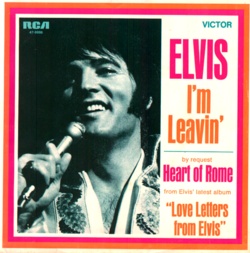 |
Highlight: Putnam’s bass run at 3:09 (the bass playing on this project is never less than superb).
3: “The First Time Ever I Saw Your Face” (Ewan MacColl)
This track is the keystone to the whole album and to the entire sessions. Perversely, it was both the first and the last secular master to be recorded: Elvis guided the band through twelve takes on 15 March, whilst singing a duet with Ginger Holliday. Elvis was clearly happy with the sprightly, acoustic arrangement because, even though he re-recorded his vocal on two further occasions, he retained the basic track recording.
A second attempt at a duet (this time with Temple Riser, 21 May) can be heard via YOUTUBE here:
Elvis apparently recorded this song at the instigation of girlfriend Joyce Bova who was very fond of the track (she was in the studio when Elvis taped the second duet). It was written in 1957 by Ewan MacColl specifically for his lover, Peggy Seeger, who first recorded it. Dozens of acts have taped their own interpretation over the years, almost all of which (including Elvis’) were loathed by the composer.
As is well known, Elvis chose to sing only the first two of the three verses (leaving out the “first time ever I lay with you” verse) but he did restore these lyrics on many of his live takes. The dropped verse could have given a clue as to whose version Elvis was channelling but I’m unable to locate a single similar performance by any other artist. Also, there seems to be no comparable musical template which means that this lyrical / musical approach to the track may well be Elvis’ own. Sadly, the rehearsal tapes are missing and so we are denied the opportunity to hear Elvis developing the song in the studio.
The only similar performance I can find with regard to the feel of the song is again from Peter, Paul and Mary who included it on their 1965 “See What Tomorrow Brings” LP. Listen here on YouTube
|
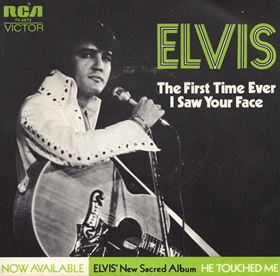 |
Of course, as far as the general public is concerned, THE version of this song is by Roberta Flack (released 1969, big hit 1972). Elvis’ performance is generally unfavourably compared to Flack’s but this is an unfair and unnecessary comparison. The hit single is slow and intimate, Elvis sings in a more joyous and majestic fashion: he is completely lost in this performance.
Are there many other instances of Elvis recording a song on three separate occasions in order to obtain the sound he’s looking for? It’s been said that when Dylan starts an album project, the first track recorded is the one to look at most carefully because that’s the one which sets the tone. This is the song Elvis brought to the first session and he wanted to sing it straight away. This is the song he was still perfecting (this time as a solo rather than as a duet) almost three months later in the wee small hours of a Gospel session.
There is great ambivalence in this track: is it a romantic song … is it a poignant song of lost love? It can be read either way and so it is with much of the LP.
Elvis sang the track on stage many times, often declaring it to be a great song and announcing how much he loved singing it: it was one of those tracks (like its predecessor on this LP) to which he almost always gave his full on-stage attention.
An epic track: this is Elvis in great form on one of the great songs. It was released as the B-Side to 'An American Trilogy'
The “Elvis: Now” [FTD] mix is preferred, again blending Elvis’ vocal beautifully among the backing singers.
Highlight: the delicate opening lines with the restrained vocal back-up.
4: “Early Mornin’ Rain” (Gordon Lightfoot)
This was one of the songs that Elvis brought with him to the March session and one of the tracks to most fully realise his vision of a folk sound. There’s little doubt that it’s the Peter, Paul And Mary version that Elvis is templating (he uses their line “Where the pavement never grows” rather than the original “Where the cold wind blows”), and he has the Nashville Edition follow their vocal echoes (“Can’t jump a jet plane”).
The song was written by Canadian singer / songwriter Gordon Lightfoot in 1964, and both Peter, Paul and Mary and Ian and Sylvia both enjoyed minor hits with it the following year. Also of interest is the 1966 country hit by George Hamilton IV which features Charlie McCoy on harmonica, Millie Kirkham on vocals, and was produced by Felton Jarvis.
 |
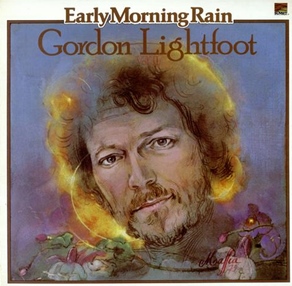 |
Elvis turns in a lovely, easy-going version which is commendable bearing in mind he was suffering major nose and throat issues at this session. It’s quite revealing that Elvis chose this as one of his five bonus songs for the “Aloha” show in 1973: the other four tracks all had clear Hawaiian connections but this song seems to have been included because Elvis just liked singing it. Indeed, within a few years Elvis would be performing the song regularly on stage during the extended band introductions, allowing rhythm guitarist John Wilkinson a chance to pick and shine.
So what is it about this song that Elvis found so appealing? Well, it’s certainly a very likeable track with a lovely tune: I suspect it’s also a relatively easy song to sing and offered Elvis a chance to deliver a laid-back stage performance in-between the showstoppers.
Another “leaving” song: restrained and tasteful with some exquisite instrumental work (the bass is glorious). The “Elvis: Now” [FTD] mix best captures the warmth of the performance.
Highlight: McCoy’s harmonica enters at 0:48
(For more discussion go here to Paul Simpson's 'Trains, Jet Planes and Morning Rain' EIN spotlight on the song)
5: “It’s Still Here” (Ivory Joe Hunter)
This was the first of the three “piano songs” that Elvis taped in the early hours of 20 May having dismissed most of the session players for the night.
There is some uncertainty and misinformation regarding the origins of this song. Some sites (including iTunes) insist that the existing Ivory Joe Hunter performance was recorded (and released?) in 1964 but to my ears it sounds like a much later recording. (Check Hunter's version on YouTube) Furthermore, I can find no evidence of a release from that year, and there would seem to be no other recording at all by any other artist before Elvis. Therefore, I suggest that Elvis’ was the first commercial recording of this track, hence the Gladys Music publishing copyright.
There have been suggestions that Elvis also recorded Hunter’s “This Old World Is Mighty / A Mite Lonesome” (Ivory Joe’s estate insists that Elvis’ people cleared the song with them) on 20 May and it is true that some tapes from this part of the session are missing. Again, I can find no trace of any commercial recording of this song which does create an obvious question: why did Elvis record or perhaps consider recording these tracks?
The answer to this may lie in the ups and downs of Ivory Joe’s career: during the 1950s, Hunter was a popular and successful RnB star and he also enjoyed occasional success in the pop / RnR markets. By the end of the decade, however, his star was on the wane and the 1960s were not kind to him. During this decade, he turned to country music, performing on The Grand Ole Opry and he switched from one record label to another in the hope of a comeback.
In 1971, Epic released an album of newly recorded material named “The Return Of Ivory Joe Hunter”. The LP was well received but flopped commercially. Elvis, a huge Hunter fan back in the day, would doubtless have noticed / purchased the album and this may have reminded him about an old Ivory Joe song he’d long wanted to record for himself, “I Will Be True” (see track 12).
|
 |
Is it possible that Elvis then arranged for his publishers to contact Hunter’s people and enquire about other tracks that were on offer? Perhaps they suggested the two above named songs and clearance was arranged for all three. Elvis, however, decided not to record all of the tracks.
Interestingly, not long after the release of “Elvis: Fool” in 1973 (which contained Elvis' edited performance of "It's Still Here"), Hunter recorded a full-blown C&W LP named “I’ve Always Been Country” and it was released shortly before his untimely death in 1974. I believe that Ivory Joe recorded his version of “It’s Still Here” during these sessions (maybe having heard Elvis’ take?) but it was left off the LP. It was (I suggest) eventually released on a posthumous album entitled “This Is My Country”.
(I welcome any contradictions to the above theory - let’s get to the truth!)
Intriguingly, although Ivory Joe and Elvis are both obviously singing the same song, the lyrics are quite different: note also that Elvis changes the opening line as he works through the outtakes of the song.
So, I have my theory as to why Elvis actually recorded the song but I have no idea as to why he chose to record the track almost solo (I think there’s also a bass on there). Maybe he’d recently seen the TTWII documentary and was impressed at how good the solo “How The Web Was Woven” sounded and decided to expand upon that? Who knows?
But what is important to note is that Elvis is making a conscious artistic decision to record these tracks in a stripped down, almost naked fashion. It’s as far away from the likes of “The Wonder Of You” as can be imagined and Elvis should receive more credit for the attempt. It’s a beautiful performance from Elvis: stark and moving. Robert Matthew-Walker (“Studies In Music”) is full of praise for Elvis’ piano playing.
Here we have a C&W song written by an afro-American Texan RnB star, who sang ballads and blues, as recorded by a white RnR star on a folk album: that’s Elvis for you. You can almost hear him directing, “Well, it doesn’t have to be strictly folk …”
I’ve plumped for the edit from “Walk A Mile In My Shoes” which has the most logical musical flow.
Highlight: Elvis re-ignites the song 2:02
(See Wiki for a brief overview of Ivory Joe Hunter’s life and career)
6: “Until It’s Time For You To Go” (Buffy Saint Marie)
The third single from this LP, this is a beautiful love song written by Canadian singer / songwriter Buffy Saint-Marie in 1965 and released on her album “Many A Mile”. (listen here on YouTube)
There were a number of non-hit single versions issued but the one that Elvis must have noticed was Neil Diamond’s 1970 offering and he follows Diamond’s style (it’s also worth checking out Bobby Darin’s 1966 take):
Peter Guralnick writes that Elvis was asked by bass player Norbert Putnam to record this song, and Putnam was following an instruction given to him by Felton Jarvis. Why Felton would need someone else to pitch songs is unclear but Guralnick suggests that because Putnam was producing Buffy the idea would make more sense coming from him. My research suggests that Putnam may possibly have known and recorded with the songwriter but his production duties didn’t necessarily start until after this session.
However it came to be, this is a lovely song and Elvis sings it simply and quietly. Here again, Elvis had more than one attempt at laying down a master, recording a more dynamic but less intimate (rejected) version during the June session.
The lyrics (“I’m not a king, I’m just a man”) are astonishingly profound for Elvis in 1971 and although some don’t care for this song I find it a sensitive and poignant performance. Elvis continued to sing the song live from late 1971 until early 1973. |
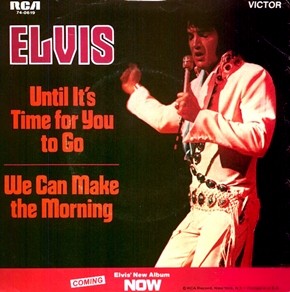 |
Although Elvis’ single stalled at #40 it’s still his take which is the “hit version” and it did climb to a respectable #9 in the adult contemporary chart. In the UK however it was very popular and charted at a respectable #5 in the Top 40.
An underrated gem, “Elvis: Now” [FTD] captures the song in all its gentle beauty. A perfect ending to the first side of the LP.
Highlight: Elvis singing the final “For you to go” at 3:29 almost in falsetto sotto voice.
(See
this interesting interview with Buffy Sainte-Marie here - she talks about recording in Nashville and Elvis, "I had such a crush on Elvis when I was 13. He's one of the reasons I decided to go into music. He had a very natural style at the time, and he was very easy on the eye then.")
More great album cover designs by David Parker / Rebel Designs
7: “Help Me Make It Through The Night” (Kris Kristofferson)
The original (somewhat jaunty) version of this modern country standard was laid down by the writer himself on his eponymous debut album from 1970. (listen here on YouTube)
However, the US hit (and Grammy Award winner) was by country singer Sammi Smith who was all over the charts with it during early 1971. (listen here)
Elvis must have heard and loved the song from the start because rather than wait to record it in a studio setting he was already singing it in Vegas in February 1971 (maybe arranged by Glen Hardin?) in a piano-led version. Elvis would still perform the song in concert right the way through to December 1976. As per both “originals”, Elvis inserts an instrumental passage halfway through the song, something he would remove from his studio takes. Elvis’ early Nashville rehearsals kick off with the band but by take 8 Elvis decides to use the (now standard) acapella introduction. This also brings about a slight change in the melody line. Of all the tracks on the LP, this would have been the current hot number: this is Elvis covering an absolutely-up-to-the-minute chart-topper. Once the Christmas recordings were out of the way (15 and 16 May), this is the first song Elvis tackled.
It seems that he had a high regard for Kristofferson’s work because (according to Guralnick) Elvis had planned to record “Sunday Morning Coming Down” at the original March session. Guralnick further asserts that Elvis’ people had been unable to secure a publishing deal and the song fell through. This is a situation that I find difficult to accept: I think it very unlikely that Elvis had any kind of publishing deal going with “Help Me Make It Through The Night” (Kristofferson was so hot he didn’t need anybody else to give his work a push) and yet he still recorded it. Why then would there be an issue with “SMCD”?
Whatever the ins and outs of the publishing situation, this is clearly a song that Elvis has brought to the session, it’s a song he cares about and invests quite some time perfecting (the finished master is the third arrangement of the song he’s worked on). It’s a decent Elvis performance of a great song. I tend to agree with Robert Matthew-Walker who feels that Elvis sings the track in an over-beefy fashion: the delicate spell of the opening verse is broken during the “I don’t care” passage.
A modern folk classic, it’s still a good opener to side 2 of the LP and “Elvis: Now” [FTD] captures the song in the best quality. |
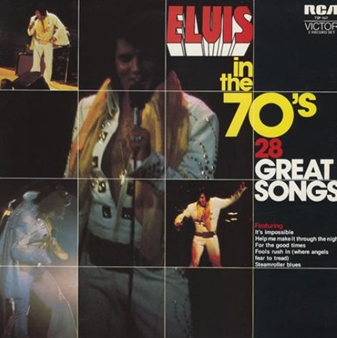 |
Highlight: the light-as-a-feather opening lines.
(Read more about the song on Wiki)
8: “It’s Only Love” (Mark James / Steve Tyrell)
Continuing the contemporary song theme, this was the second single from this LP and was originally a minor hit for BJ Thomas on the Scepter label in 1969. (listen to BJ Thomas version on YouTube)
There are enough BJ Thomas and Mark James connections in Elvis’ career to fill a small book and it’s interesting to note that BJ’s single was recorded at American and produced by no less a genius than Chips Moman. Co-songwriter Steve Tyrell was head of A&R at Scepter Records.
This is the one track that doesn’t fit in with the LP’s folk theme (although the lyrics still carry the lost love concept) but is included for its likeability factor. It’s a pop song which has a gentle nod in the rock direction.
During the early takes, one can hear Elvis struggling with the Thomas arrangement before deciding to simplify the structure (it’s possible to almost recreate the original arrangement by splicing takes 3 and 7). Generally speaking, Elvis follows BJ’s template and produces a decent pop song and, even though he’s not singing particularly well, he still has the ability to thrill with the high note on “throw it aside”: compare this section to the outtakes and you’ll see what I mean.
A disappointing #19 hit on the Adult Contemporary Chart and a disastrous #51 on the regular chart, the song remains popular, particularly in the UK where it registered as a #3 smash on the BBC chart when re-issued in 1980.
The “Elvis: Now” (FTD) mix is excellent but “Elvis Aron Presley” delivers a few extra seconds and that wins the vote.
Highlight: the high note on “throw it aside” as mentioned above. |
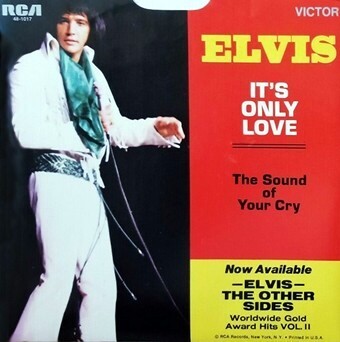 |
(Note: See BJ Thomas website for more fascinating info)
9: “I’ll Take You Home Again, Kathleen” (Thomas Westendorf)
There have been innumerable versions of this pseudo-Irish classic and it would be impossible to track down Elvis’ direct inspiration but as a movie and a cowboy fan he must have heard The Sons of the Pioneers’ beautiful take from the 1950 western “Rio Grande”.
He may also have heard The Platters 1959 version on their “The Flying Platters Around The World” LP.
The 1957 Slim Whitman single could also be a source (the B-Side was “Careless Love”) and for those who like their connections and originals presented as a full circle, it’s worth noting that Ivory Joe Hunter recorded a version in September 1956.
“I’ll Take You Home Again, Kathleen” was written as an answer song to George Persley’s “Barney, Take Me Home Again”, both of which were published circa 1876 (technically, therefore, Elvis is singing this track as a character called Barney).
This is the second of the “piano songs” (see tracks 5 and 12) on the LP and also the second to be recorded. What is particularly fascinating is that although no 1971 outtakes have surfaced, we can hear Elvis’ singing the song on the 1959 Germany home-demo tape, again accompanied by just his own piano playing. Without question, his vocals are better, purer, on the German take but there is greater artistry on the Nashville recording - it’s as if he’s traded that choir-boy voice at the crossroads for an unparalleled ability to emote. His piano playing is also superior on the studio version.
There are other written verses but Elvis sticks with what generally seems to the standard lyric. Curiously, Elvis inserts the adjective “soft” into the song twice: “Your voice is soft (sad) whene’er you speak” and “When the fields are soft (fresh) and green” which he doesn’t do in 1959.
At first sight, this appears to be an odd choice for a mainstream pop album but Elvis had previously and successfully recorded several old classics: “Old Shep”, “That’s When Your Heartaches Begin”, “Are You Lonesome Tonight?” to name but three. This is also the oldest song on the LP and in that sense fits the folk (songs of the people) concept well. |
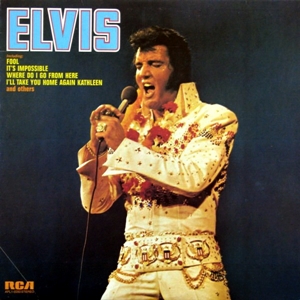 |
It would be almost six years before Elvis reached for something similar when he taped the definitive “Danny Boy” at Graceland.
Actually, for all this, the boogie-woogie uptempo alternative take from 1959 is possibly the best of the available versions: Elvis’ tongue-in-cheek irreverence is irresistible.
The “Elvis: Fool” (FTD) mix is excellent and the tasteful strings overdubs add just enough colour.
Highlight: Elvis’ “Kathleen” chiming perfectly with his two piano notes at 1:39.
(See Wiki for more info and other artists versions)
10: “(That’s What You Get) For Lovin’ Me” (Gordon Lightfoot)
Again, there’s no doubt that Elvis is channelling the Peter, Paul and Mary sound on this Gordon Lightfoot number (see track 4): this comes from their 1965 LP “A Song Will Rise” (both Lightfoot originals feature on his 1966 eponymous debut). (listen to Gordon Lightfoot original) What is particularly interesting though, is that lyrically Elvis is taking his cues from Waylon Jennings’ 1966 Beatlesque country hit. (Listen here to Waylon Jennings via YouTube)
You’ll note that Elvis uses the Jennings’ line “You should have known how things would end”, a much better lyric than the original which simply repeats the previous “Now there you go you’re crying again”. He also completely ditches the “Moving is my stock-in-trade” part and replaces the “I’ve got a hundred more like you” line with the subtly different but much sexier “I’ve had a hundred just like you”.
This is a most unusual song in the Elvis canon: Elvis portrays himself as a serial philanderer, happy to break hearts in a callous fashion wherever he may wander. Indeed, it may be seen as the reverse of the usual Elvis lost-love lyric where it’s the singer who has been wronged. By also using the faster tempo (again, from Jennings) Elvis adds to the breezy devil-mare-care feel. As such, it’s a fascinating extension of the theme of this LP (and the next track takes a not dissimilar stance) and helps to present a rounded view of the topic.
This was the last of the four songs Elvis recorded in March, just before his eye problems forced the early closure of the session. If Elvis was willing to step this far out of type this early into the proceedings then it is indeed a great shame that the project was interrupted. |
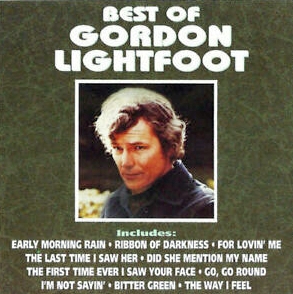 |
“Elvis: Fool” (FTD) is the only CD mix to capture the full deep woody sound of this acoustic gem.
Highlight: Elvis’ wordless mumbling during the chorus: 0:43.
11: “Don’t Think Twice, It’s All Right” (Bob Dylan)
Elvis almost certainly learnt this track from the Peter, Paul and Mary version (hit single 1963) taken from their “In The Wind” LP which also featured “Blowin’ In the Wind” and “All My Trials”.
But he may also have been familiar with Waylon Jennings’ breezier rendition from his 1970 compilation LP named for this track.
And he must have heard Odetta’s take too (“Odetta Sings Dylan” 1965). Dylan’s original came from his first hit album (“The Freewheelin’ Bob Dylan” 1963) and popular Dylan writer Paul Williams has listed it among a handful of genuine Bob masterpieces. This is the second of the shoulder-shrugging no-big-deal songs (see track 10) which allowed Elvis to step out of his usual recording character and portray himself as the (more true to life?) casual womaniser.
It was taped during the second night of recording as Elvis was completing the Christmas LP in May and was obviously played off-the-cuff, Elvis probably relishing the chance to break away from the less than inspiring festive material. Jorgensen writes that it was inspired by a stray guitar lick from James Burton and also suggests that this was one of the songs that Elvis brought with him in March.
The full jam (or at least that which was taped) runs to 9:19 (“A Life In Music” suggests 11:25 for some reason) and it has been released in various edits over the years. For me, the best remains the “Our Memories Of Elvis” edit (8:35) which cleverly gives the song a sense of structure by editing on a neat introduction.
Elvis uses just two of the four original verses but his casual, freewheeling style gives the song great energy and the band are with him every step of the way. It’s a delight to hear Elvis is such excellent form (there’s none of the tension and edginess that you hear on almost all of the other 1971 vocals) and for me this is a work of genuine brilliance. In many ways, it’s comparable that other half-remembered jammed gem of the previous evening, “Merry Christmas, Baby”. You might even say that this is the other side of the coin, the bright and perky folk kiss-off track balancing the slow, lazy blues celebration.
Dylan gave a press conference in 1965 in which he claimed, “All my songs basically say is 'Good luck.' They all tail off at the end with good luck, hope you make it”, and I think this song demonstrates that very well: there’s no bitterness in Elvis’ singing - this is a glorious penultimate track, interjecting a much-needed burst of good humour and humanity. |
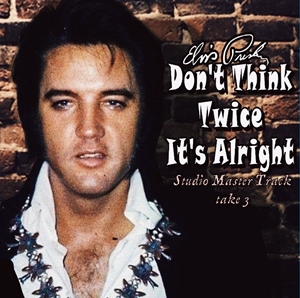 |
Highlight: Elvis’ higher note on “Heading down that long lonesome road, babe”: 6:29
(For more info about the song see Wiki)
12: “I Will Be True” (Ivory Joe Hunter)
Here is Ivory Joe's original single from my own collection.
The final track acts as a postscript to the LP: Elvis interprets Ivory Joe Hunter’s 1952 MGM single as a simple solo performance. Again, seated at the piano, this time he has no bass or strings to act as support. This is just Elvis.
Here we have another rare opportunity to compare an earlier Elvis’ performance as the 1959 Germany tape contains an almost identical vocal although Elvis’ early piano playing is probably attempting to copy the accompaniment on the Ivory Joe original. The 1971 master makes no such attempt and the playing is simple and stark.
A declaration of intent that Elvis had kept in the back of his mind for almost 20 years before laying down this beautiful and moving interpretation.
Highlight: the high note on “Un-til the day” 2:03
(See this site for more about Hunter’s early life and career) |
 |
Final thoughts
This LP would not have been a big seller: there were no hit singles to push it into the top 10. But I do believe it would have been well accepted critically. In particular, I think it’s worth noting the absolute contrast between this delicate / broken singer and the cocksure frontman of the “Elvis Country” project.
Elvis is not necessarily singing well from a technical point of view, but as an expression of emotion this is a beautiful piece of work and the band is in excellent form.
Elvis uses a splendid selection of (relatively) contemporary folk-songwriters mixing old and new tracks to great effect. It’s worth noting that, had he had the inclination, Elvis could have recorded seven of these songs in 1966 alongside his version of “Tomorrow Is A Long Time” - that would have been a fascinating listen.
Elvis came into these sessions as The Man: his recent LPs, singles, concerts, TV shows, JC’s Award and MGM documentary had all marked him as an immensely talented and successful artist. During this year Elvis recorded a Grammy Award winning Gospel album, half of a great Christmas LP (the rest was at least listenable) and, as detailed above, the basis for a fascinating secular LP.
Many writers have portrayed the 1971 sessions as chaotic which may be justified but I feel that their opinions may be one-sided: Guralnick manages to write four pages about the sessions without once mentioning the undisputed masterpiece that is “Merry Christmas, Baby”.
The job of a producer is not only to work in the studio with the artist but also to sift through the recorded material to find the heart and soul of the LP that has been recorded. Clearly, songs like “Fools Rush In” had no place on an album of this nature and issuing the above listed 12 songs over two albums and singles was a grave error which robbed Elvis of a potentially vital LP.
This, then, is "Elvis Presley: Exodus": this is how I choose to listen to the great Elvis secular recordings of 1971.
Go here to SPOTIFY to listen to this 1971 album
Click here to comment on this article
NOTE: EIN thanks George Smith for this brilliant article - it was first posted on the FECC Elvis forum
Designer David Parker (Rebel Designs) has created some stunning alternate cover art for both CD and vinyl versions of this album.
Parker's 'Memory Revival' website showcases both George Smith’s original article and new designs, along with some background information on the design process.
Go here for - 12" album artwork & CD jewel case designs
&
Illustrated PDF booklet:
With thanks to David Parker who gave EIN permission for use of his work.
|
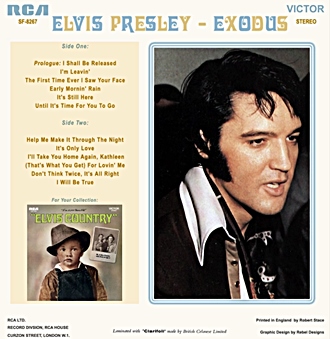 |
Spotlight by George Smith.
-Copyright George Smith / EIN November 2021.
EIN Website content © Copyright the Elvis Information Network.
Click here to comment on this article
'Walk A Lonely Street' Book Review: Recently published Tony Plews, 'Walk A Lonely Street: Elvis Presley, Country Music & The True Story of Heartbreak Hotel' is a unique volume that tells the tale of Elvis Presley’s rise to fame as viewed through the lens of his era-defining first hit record, “Heartbreak Hotel”. Presented as a series of consecutive short stories, it offers a new perspective on Presley’s musical and cultural achievements, and reveals the true and dramatic saga behind the breakthrough song that changed the world.
In EIN Piers Beagley's detailed review he discovers that.. the true joy of this book is Tony Plews’ delightful and engaging writing style. His detailed research and his mix of facts and imagination blend together to create an emotional narrative that really draws the reader in. At times he also adds a nice British, somewhat droll, sense of humour that can make you laugh out loud. A totally enthralling musical journey, Tony Plews writes with a truly engaging, colourful and passionate style. If your love of Elvis is based upon his amazing musical legacy then this is the book for you....
Go here to EIN's 'Walk A Lonely Street' in-depth review
(Book Review, Source;ElvisInformationNetwork) |
 |
Tony Plews - 'Walk A Lonely Street' - INTERVIEW: Recently published author Tony Plews' 'Walk A Lonely Street: Elvis Country Music & The True Story of Heartbreak Hotel' is a unique volume that tells the tale of Elvis Presley’s rise to fame as viewed through the lens of his era-defining first hit record, “Heartbreak Hotel”.
The book, Walk A Lonely Street, spans over one hundred years and involves scores of singers and their songs, it uncovers the truth, placing events in context, and revealing the astonishing depth of Presley’s artistic vision and achievements.
It is unlike any Elvis book that you will have read before.
EIN wanted to know some answers such as.....
- Part biography, part investigation, part reference and part thriller, how did he come up with the concept
- Why does a book about "Heartbreak Hotel" start in 1865
- How did he find connections to Mae Boren Axton, Tommy Durden and even Delta Pinney (who shot that lonely man) and what did they think when he came calling?
EIN's Piers Beagley interviewed author Tony Plews to find out how he came up with such an incredible concept for his first book - and what discoveries he made along the way...
(Interviews, Source;ElvisInformationNetwork) |
 |
‘Bicycle Rider: Thoughts on The Searcher’: One of EIN’s most insightful contributors George Smith has written a stunning essay on the new HBO documentary ‘Elvis Presley: The Searcher’.
In his review ‘George Smith’ captures the essence of the narrative, Zimny’s production decisions and notes the difficulty of having to create a documentary about Elvis’ music and having to keep it under 4 hours.
His review includes,
“The genius of the documentary though, is in its decision to present Elvis Presley to all viewers in a new and unexpected fashion. For the devotees this is realised through the constant use of new film (professional and amateur) and studio outtakes: it keeps the faithful on their toes and creates the impression of seeing and hearing Elvis anew. This is why Zimny insisted on using the alternative Aloha, the handheld “Trilogy” and “Never Been to Spain”, the “Burning Love” rehearsal, the “If I Can Dream” outtake, the off-air segments from ’68, the non-masters of “Lonely Man”, “Hurt”, “Suspicious Minds”, “Loving You”.. It is a deliberate and clever approach which was much appreciated by this writer.”
Go here to “Bicycle Rider: Thoughts on The Searcher” this is essential reading.
(Spotlight; Source;GeorgeSmith/ElvisInfoNet)
|
 |
Elvis "Non Stop Erotic Cabaret": 45 years ago today Elvis’ performance from the midnight show at the Las Vegas International on August 12, 1970 has been described by his record company as " Probably the best live concert ever recorded by Elvis Presley."
This stunning performance has been released by SONY on last year's "That's The Way It Is' Deluxe box-set as well as the June 2000 BMG 'That’s The Way It Is: Special Edition' 3cd set.
When he decided to investigate in-depth author George Smith discovered however that this 1970 Midnight performance was not just "the best live concert ever recorded by Elvis Presley"; it is an almost spiritual experience. But, like most great albums and concerts of that nature, it cannot be rushed: one must sit and listen to the show in its entirety. Then, and only then, can the genius of Elvis the performer be fully appreciated.
The show takes the form of a metaphorical sexual act with Elvis wooing, loving, and then ravishing his audience before twice taking it to an exhausting musical peak.
(Spotlight; Source;GeorgeSmith/ElvisInfoNet) |
 |
EIN Website content © Copyright the Elvis Information Network.
Elvis Presley, Elvis and Graceland are trademarks of Elvis Presley Enterprises.
The Elvis Information Network has been running since 1986 and is an EPE officially recognised Elvis fan club.


















